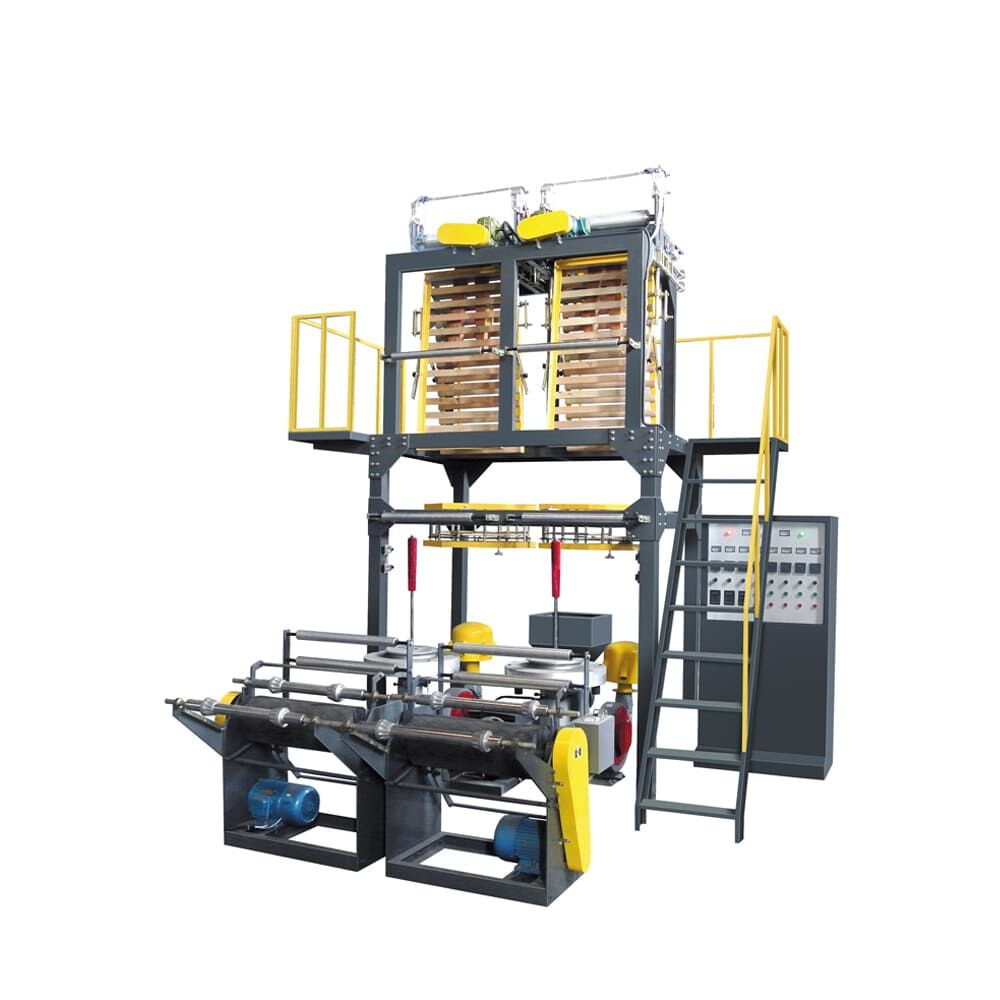How MultiLayer Blown Film Extrusion Enhances Performance and Functionality
What Is MultiLayer Blown Film Extrusion
Multi Layer Blown Film Extrusion, or MLBFE as it's commonly called in the industry, brings together between 2 and 11 different polymer layers into one unified film structure. What sets this apart from regular single layer systems is how it lets producers mix materials strategically. The result? Films that strike just the right balance between things like how well they block out moisture, their structural integrity, and what they cost to produce. For packaging companies especially, this layering technique means they can create products that meet exact customer needs. A food packaging film might need extra protection against oxygen while still being lightweight enough for shipping. And here's the kicker nobody wants to compromise on quality or green credentials when doing so makes business sense too.
Core Components of Multi-Layer Blown Film Extrusion Machines
Modern systems rely on three critical components:
- Multi-extruder systems: Separate extruders melt distinct polymers—such as ethylene-vinyl alcohol (EVOH) for oxygen barriers and polyethylene (PE) for sealing—ensuring each layer retains its intended properties.
- Coextrusion die: Merges molten layers while maintaining temperature isolation, with advanced spiral die designs enabling uniform layer distribution and minimizing interfacial instability.
- Air-ring cooling: Delivers controlled, symmetrical cooling to ensure consistent thickness and mechanical integrity across all layers, especially vital for high-barrier applications.
How Co-Extrusion Process Enhances Film Functionality
The co extrusion process lets manufacturers place different functional materials exactly where they need them in the film structure. Take EVOH for instance when sandwiched between those tough polyolefin layers it forms what many call one of the best oxygen barriers available today. A recent report from Packaging Strategies back in 2023 showed something pretty impressive about these seven layer films they cut down on oxygen transmission rates by almost 92 percent over regular single layer options which means food stays fresh longer about four to six extra weeks on average. And here's another benefit this method not only boosts performance but also cuts down on material waste since we can make thinner films without sacrificing quality.
Common Layer Configurations in Blown Film (3, 5, 7, 9-Layer)
| Layers | Primary Use Cases |
|---|---|
| 3 | Basic barrier films (e.g., snacks) |
| 5 | Medium-barrier medical packaging |
| 7 | High-barrier frozen food films |
| 9 | Ultra-barrier pharma applications |
Each configuration balances functionality and cost, with higher layer counts offering superior protection for sensitive products like pharmaceuticals and long-shelf-life foods.
ABA vs ABC Co-Extrusion Configurations: Structural and Functional Differences
The ABA configuration features matching outer layers made from materials like LDPE surrounding a central layer that could be adhesive or some kind of barrier resin. These setups work really well when budget matters most for keeping moisture out. On the flip side, ABC structures bring something different to the table by combining three separate materials. This gives manufacturers more flexibility in what they can achieve. According to recent research published in the Materials Innovation Report last year, ABC films actually stand up better against punctures compared to their ABA counterparts, about 40% improvement if memory serves right. That's one reason why many industries choose ABC films for tough jobs such as those big thick agricultural covers that need to withstand rough handling and harsh weather conditions over long periods.
Single-Layer Blown Film Extrusion: When Simplicity and Cost Efficiency Matter
The single layer blown film extrusion method works best when we need simple operations and keep costs down for basic packaging needs where fancy barriers or multiple materials just aren't necessary. We see these kinds of systems all over the place in markets that want lightweight packaging which can be recycled easily, especially in areas where governments have cracked down hard on plastic waste problems. Since they work so well with packages made from just one type of polymer, this approach actually helps move toward those circular economy ideas everyone talks about nowadays. Plus it makes recycling at the end of product life much easier than dealing with complex mixed material films.
Basics of Single-Layer Blown Film Machines
In single layer systems, just one extruder melts materials such as low density polyethylene or high density polyethylene. These materials pass through a round die that creates a long tube shape. Then comes the interesting part where air gets blown into what's called a bubble, making it grow upwards until it reaches the right size. Once cooled down properly, the film collapses between those roller things known as nippers before getting rolled up onto big spools ready for whatever comes next in production. The whole setup works better from an energy standpoint too since these machines typically use around 15 to 20 percent less power compared to multi layer alternatives according to some research from Polymer Processing Institute back in 2023. This makes them great choices when manufacturers need to crank out regular quality films quickly without breaking the bank on electricity costs.
Typical Applications of Monolayer Blown Film Technology
Monolayer films account for 62% of non-food flexible packaging due to their cost efficiency in high-volume applications. Key uses include:
- Retail shopping bags and basic protective wraps
- Agricultural ground covers with UV stabilization
- Temporary construction moisture barriers
Industrial packaging studies confirm these films meet ASTM D882 tensile strength standards for lightweight loads (≥5 kg). While they lack the oxygen barrier capabilities needed for perishables, their recyclability makes them a sustainable choice for short-life, low-risk applications.
Comparing Film Quality: Strength, Barrier Properties, and Surface Characteristics
Film quality directly impacts performance across packaging, agriculture, and industrial sectors. Three key factors—mechanical strength, barrier effectiveness, and surface characteristics—highlight the advantages of multi-layer over single-layer technologies.
Thickness Uniformity and Functional Performance in Single vs Multi-Layer Systems
Multi-layer systems achieve ±5% thickness uniformity, significantly tighter than the ±15% typical of single-layer films (Plastics Engineering Journal 2023). This precision ensures consistent performance of critical functional layers, such as oxygen barriers. A 2023 study showed that seven-layer films maintain 94% barrier efficiency even when total thickness is reduced by 22% compared to monolayer equivalents.
Mechanical Strength and Barrier Properties: A Direct Comparison
When manufacturers combine rigid core layers with pliable outer materials, they get multi-layer films that resist tearing about 30 to 50 percent better than standard options. The oxygen barrier properties are impressive too. Single layer polyethylene films let through around 1,200 cc per square meter per day, but when we look at five layer structures containing EVOH, those numbers plummet to only 15 cc per square meter daily according to Flexible Packaging Association research from last year. These kinds of improvements mean food stays fresh longer on store shelves, sometimes extending shelf life by nearly a quarter. For companies selling premium products where freshness matters most, these multilayer films have become practically indispensable in modern packaging solutions.
Surface Finish and Optical Properties: Gloss and Clarity in Packaging Films
Multi-layer systems produce films with superior aesthetics and functionality, achieving 85–90 gloss units (GU) versus 40–60 GU in monolayer films (Packaging Digest 2023). Co-extruded surface layers also enhance slip properties (coefficient of friction 0.2–0.3) for smooth unwinding and reduce haze to below 5%—critical for clear pharmaceutical blister packs and high-end retail packaging.
Application-Specific Advantages in Packaging, Agriculture, and Construction
Packaging Applications: Balancing Simplicity and High Performance
Multilayer blown film extrusion works best when regular single layer stuff just won't cut it anymore. The technology gives manufacturers tight control over oxygen and moisture barriers which are super important for keeping food fresh longer. Plus these films still look great when printed on so brands can maintain their visual identity. According to latest numbers from the 2024 Packaging Materials Report, around 78 percent of all shelf stable food packaging now uses multilayer films because they hold up better during transport and storage while being easier to work with in manufacturing processes. On the flip side, simple single layer options continue to be popular for things like dry goods where budget matters most. These basic systems typically save between 30 to 40% on production costs compared to multilayer alternatives, making them practical choice for applications such as wrapping materials that don't require high barrier properties.
Agricultural Films: Durability Needs vs. Cost Constraints
Farmers dealing with agricultural films face a tough balancing act between harsh weather conditions and slim profit margins. That's why many turn to multilayer setups these days. These films feature UV protection on the outside and anti-fog properties inside, which helps greenhouses last around five to seven seasons before needing replacement. The silage wrap market tells a different story though. Most operations stick with single layer blown film products that control about two thirds of the market share. Sure, they don't last as long and thickness can vary quite a bit from roll to roll, but when budgets are tight, cost becomes king over longevity in many farming situations.
Construction and Industrial Uses of Monolayer and Multilayer Blown Film
When it comes to construction materials, those 9 layer co extruded geomembranes really stand out when it comes to resisting punctures they can handle well over 500 Newtons of force. That makes these membranes perfect choices for lining landfills or covering ponds where durability is absolutely critical. On the other hand, simple single layer films work just fine as temporary vapor barriers in many residential building projects. The real game changer happens in industrial chemical packaging though. Multilayer structures featuring EVOH cores cut down on solvent permeability to less than 0.5 grams per square meter per day which represents about a 90 percent improvement compared to regular single layer films. This kind of performance isn't just impressive on paper it actually ensures safer handling of chemicals and helps companies stay compliant with all the necessary regulations.
Cost Analysis and ROI: Evaluating Investment in Single vs Multi-Layer Extrusion Systems
Initial Machine Investment and Operational Costs Compared
Single-layer systems require 50–70% lower initial investment than multi-layer setups, with entry-level machines priced at $200k–$350k compared to $500k–$1.2M for 3–7 layer systems (Plastics Technology Report 2023). However, operational differences influence long-term economics:
| Cost Factor | Single-Layer Systems | Multi-Layer Systems |
|---|---|---|
| Energy Consumption | 18-22 kWh/kg output | 24-28 kWh/kg output |
| Labor Requirements | 1-2 operators | 2-3 skilled technicians |
| Scrap Rates | 8-12% | 5-8% |
Despite higher energy use, multi-layer systems reduce polymer waste by 30–40% through optimized layer distribution, particularly beneficial in food packaging where material savings offset energy costs.
Long-Term ROI of MultiLayer Blown Film Extrusion Equipment
Although requiring 2.3x more upfront capital, advanced 7-layer systems achieve ROI 42% faster than single-layer models in barrier film production (Global Film Markets Analysis 2024). This advantage stems from:
- Premium pricing for high-performance films ($0.18–$0.25/lb vs $0.12–$0.15/lb for monolayers)
- Expanded market access to pharmaceutical, medical, and industrial sectors
- Longer equipment lifespan (30–50%) enabled by modular upgrades and robust engineering
Leading manufacturers report payback periods of 26–34 months for multi-layer systems, compared to 40–48 months for single-layer operations in flexible packaging environments.
Frequently Asked Questions (FAQ)
What is MultiLayer Blown Film Extrusion?
MultiLayer Blown Film Extrusion involves combining multiple polymer layers, ranging from 2 to 11, into a single film structure, enabling the strategic mixing of materials for enhanced film properties.
Why are multi-layer films better than single-layer films?
Multi-layer films offer improved mechanical strength, barrier properties, and surface characteristics over single-layer films, providing advantages in various applications like packaging and construction.
What are the core components of Multi-Layer Blown Film Extrusion machines?
Core components include multi-extruder systems, a coextrusion die, and air-ring cooling, each playing a crucial role in the film extrusion process.
How do ABA and ABC co-extrusion configurations differ?
ABA configurations involve matching outer layers around a central layer, while ABC structures utilize three different materials for greater flexibility and performance.
Is it cost-effective to invest in multi-layer extrusion systems?
While multi-layer systems require higher initial investments than single-layer systems, they offer faster ROI, reduced polymer waste, and access to premium markets, making them cost-effective over time.
Table of Contents
- How MultiLayer Blown Film Extrusion Enhances Performance and Functionality
- Single-Layer Blown Film Extrusion: When Simplicity and Cost Efficiency Matter
- Comparing Film Quality: Strength, Barrier Properties, and Surface Characteristics
- Application-Specific Advantages in Packaging, Agriculture, and Construction
- Cost Analysis and ROI: Evaluating Investment in Single vs Multi-Layer Extrusion Systems
- Frequently Asked Questions (FAQ)




